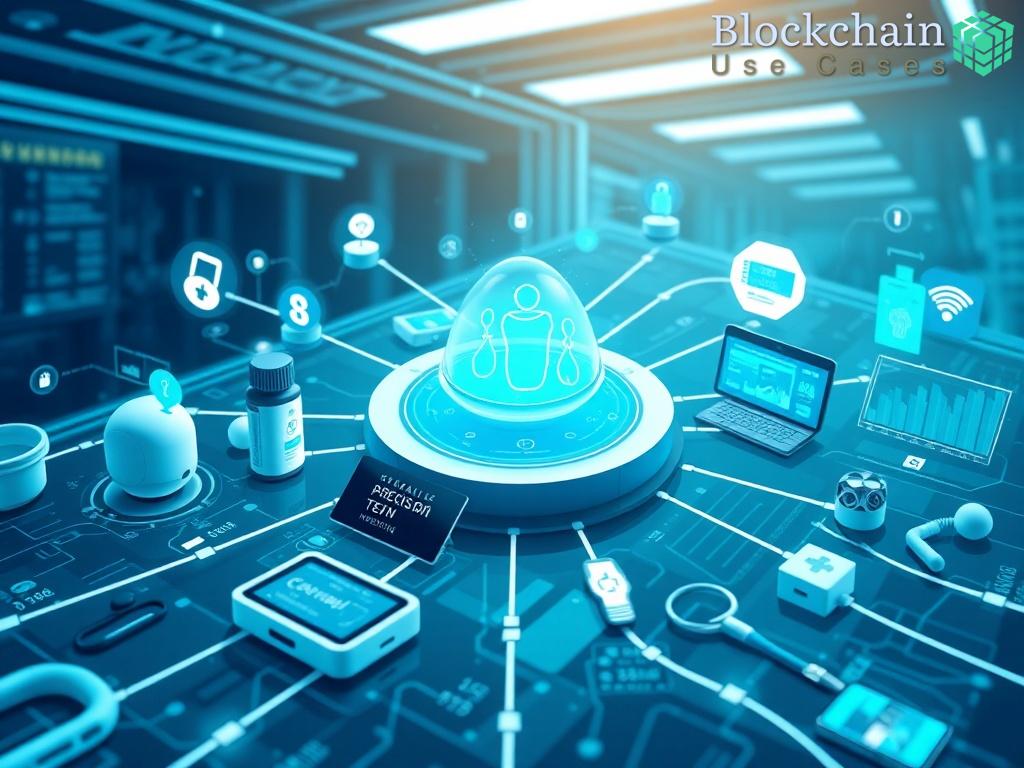Integrating Blockchain for Enhanced Data Integrity

The integration of blockchain technology into IoT-based industrial control systems marks a significant evolution in data integrity management. As industries increasingly rely on interconnected devices, ensuring the accuracy and reliability of data transmitted across these systems becomes paramount. Blockchain’s decentralized nature offers a robust solution to the challenges posed by traditional data handling methods, where single points of failure or manipulation are prevalent.
One of the most compelling advantages of blockchain technology is its decentralized architecture. Unlike traditional centralized databases, where a single entity controls the data, blockchain enables multiple parties to participate in the data validation process. This democratization of data not only enhances transparency but also significantly reduces the risk of data tampering. The following table outlines the key differences between centralized and decentralized systems:
| Feature | Centralized Systems | Decentralized Systems |
|---|---|---|
| Control | Single entity | Multiple participants |
| Data Integrity | Vulnerable to tampering | Enhanced through consensus |
| Transparency | Limited visibility | Increased visibility for all participants |
| Failure Points | One point of failure | No single point of failure |
In addition to ensuring data integrity, blockchain technology empowers the implementation of smart contracts, which can automate processes and enforce agreements in real-time. These self-executing contracts, which are written into the blockchain, can significantly reduce the need for intermediaries and minimize the risk of human error. By automatically executing transactions when predefined conditions are met, smart contracts enhance the reliability of IoT systems. The following list highlights the benefits of using smart contracts in industrial control systems:
- Increased Efficiency: Reduces processing time by automating transactions.
- Cost Reduction: Minimizes the need for intermediaries, lowering operational costs.
- Enhanced Security: Reduces the risk of fraud through immutable records.
- Improved Compliance: Ensures adherence to regulations with automated checks.
Decentralized Access Control Mechanisms in IoT Systems

The implementation of decentralized access control mechanisms within IoT-based industrial control systems represents a transformative step towards fortified security. In an era where cyber threats are increasingly sophisticated, traditional access control measures often fall short. By leveraging blockchain technology, organizations can establish a framework that not only enhances security but also promotes a more efficient and transparent management of access rights.
Decentralization plays a pivotal role in redefining access control. With blockchain, the control of access rights is distributed among multiple stakeholders rather than being centralized within a single authority. This shift reduces the risk of unauthorized access and malicious attacks that often exploit central points of management. In a decentralized model, every action involving access permissions is recorded on the blockchain, creating an immutable ledger that can be audited at any time. This transparency not only fosters trust among collaborators but also provides a clear trail of accountability.
Furthermore, smart contracts serve as a powerful tool in the realm of decentralized access control. By employing these self-executing contracts, organizations can automate the process of granting and revoking access based on pre-set conditions. For instance, when a device joins the network, the smart contract can automatically verify its identity against a whitelist before granting access. This seamless integration minimizes human intervention and the potential for errors, thus enhancing the overall security posture of IoT systems.
The dynamic nature of decentralized access control mechanisms also allows for real-time adjustments to permissions. Unlike traditional systems where changes may take time to propagate, blockchain can update access rights instantaneously across the network. This agility is crucial in environments that require rapid responses to security threats or changes in operational protocols. Moreover, by employing cryptographic techniques, these mechanisms ensure that only authorized entities can modify access rights, thereby fortifying the system against internal and external threats.
In conclusion, the marriage of blockchain technology with decentralized access control mechanisms offers a promising frontier in the quest for enhanced security in IoT-based industrial control systems. As industries continue to evolve and embrace interconnected technologies, adopting these innovative approaches will be essential for safeguarding critical infrastructures against the growing tide of cyber risks.
Smart Contracts for Automated Security Protocols

The emergence of smart contracts within blockchain technology has paved the way for a new era in the automation of security protocols for IoT-based industrial control systems. These self-executing agreements not only streamline operational processes but also bolster security measures, providing organizations with a powerful tool to combat the evolving landscape of cyber threats. By leveraging the capabilities of smart contracts, businesses can automate crucial security functions, ensuring that their IoT environments remain resilient against unauthorized access and data breaches.
Automating Compliance and Security Checks is one of the foremost advantages of integrating smart contracts into industrial security protocols. By embedding compliance requirements directly into the contract code, organizations can ensure that every action taken within the IoT ecosystem adheres to established security standards. For instance, if a device attempts to connect to the network, the smart contract can execute a series of predefined checks, such as verifying the device’s credentials and assessing its compliance with security policies. This automation not only accelerates the verification process but also minimizes the risk of human error that often leads to security vulnerabilities.
Furthermore, the use of smart contracts facilitates real-time incident response. In traditional systems, the process of identifying and responding to security breaches can be slow and cumbersome, often involving multiple stakeholders and layers of approval. However, with smart contracts, organizations can define specific triggers that automatically initiate predefined responses. For example, if an anomaly is detected, the smart contract can promptly revoke access permissions for the compromised device, effectively containing the threat before it escalates. This agility in response is crucial in safeguarding critical infrastructure against increasingly sophisticated attacks.
Enhancing Transparency and Accountability is another critical aspect of smart contracts in the context of security. Each transaction and access modification is recorded on the blockchain, creating an immutable audit trail that can be accessed and reviewed by authorized parties at any time. This transparency fosters trust among stakeholders and ensures that all actions are accountable. In the event of a security incident, organizations can easily trace the origins of the breach, allowing for more effective incident analysis and remediation.
In summary, the incorporation of smart contracts into security protocols for IoT-based industrial control systems represents a transformative advancement in the fight against cyber threats. By automating compliance checks, enabling real-time incident responses, and enhancing transparency, organizations can significantly strengthen their security posture. As the industrial landscape continues to evolve, embracing these innovative solutions will be paramount in ensuring the protection of critical assets and data.
Real-time Threat Detection through Blockchain Analytics
As industries continue to embrace the connectivity afforded by IoT devices, the need for robust security measures becomes increasingly critical. One of the most promising advancements in this realm is the utilization of blockchain analytics to facilitate real-time threat detection. By harnessing the decentralized and immutable nature of blockchain, organizations can monitor their networks for anomalies and respond swiftly to potential security breaches, thereby safeguarding their industrial control systems effectively.
Dynamic Monitoring of Network Activities is a cornerstone feature of blockchain analytics in the context of IoT security. By continuously tracking the interactions between devices on a blockchain network, organizations can identify unusual patterns that may indicate a cyber threat. For instance, if a device begins communicating with an unusually high number of endpoints or attempts to access resources outside its normal parameters, the system can flag this behavior in real-time. The transparent audit trail provided by blockchain enables security teams to drill down into these anomalies and assess whether they are genuine threats or benign activities.
Furthermore, the integration of machine learning algorithms with blockchain analytics enhances the capability to detect threats proactively. These algorithms can analyze historical data recorded on the blockchain to establish baseline behavior for devices within the network. By continuously learning from new data, the algorithms can improve their detection accuracy over time, minimizing false positives and ensuring that security teams can focus on legitimate threats. This combination of blockchain’s reliability and machine learning’s predictive capabilities creates a formidable defense against cyber attacks.
Real-time Incident Response is another critical advantage of employing blockchain analytics in industrial control systems. Once a potential threat is detected, the response can be automated through the deployment of smart contracts, which are integral to the blockchain framework. For example, if a device exhibits suspicious behavior, a smart contract can trigger an immediate response—such as revoking access permissions or isolating the device from the network. This automation not only accelerates reaction times but also reduces the potential damage caused by security incidents.
The synergy of blockchain analytics and real-time threat detection ultimately leads to a more resilient IoT ecosystem. By providing organizations with the tools to monitor, analyze, and respond to threats instantaneously, these innovations foster a proactive security posture. As industries move towards greater digitization, adopting such advanced security measures will be paramount in protecting critical infrastructure from the ever-evolving landscape of cyber threats.
Case Studies: Blockchain Implementation in Industrial IoT Security
In recent years, several industries have begun leveraging blockchain technology to enhance the security of their IoT-based industrial control systems. These case studies illustrate not only the effectiveness of blockchain in addressing security challenges, but also its potential to revolutionize operational protocols across various sectors. By examining real-world implementations, organizations can gain valuable insights into the benefits and implications of adopting this advanced technology.
One notable example comes from the energy sector, where a major utility company implemented blockchain to secure its grid management systems. By utilizing a decentralized ledger, the company was able to track real-time data from a multitude of IoT devices, such as smart meters and sensors, without the risk of data manipulation. The introduction of smart contracts automated the verification process for energy transactions, ensuring that all participants adhered to agreed-upon terms. This transformation not only enhanced data integrity but also optimized energy distribution, demonstrating blockchain’s ability to safeguard critical infrastructures while improving operational efficiency.
The healthcare industry, known for its stringent data security requirements, has also turned to blockchain to fortify its IoT systems. A prominent healthcare provider launched a pilot project that integrated blockchain to manage patient data across its network of connected devices. By employing a decentralized access control mechanism, the organization ensured that patient data was only accessible to authorized personnel. Moreover, blockchain’s immutable nature provided a transparent audit trail that enhanced accountability and compliance with regulations like HIPAA. This case exemplifies how blockchain can not only protect sensitive information but also foster trust among stakeholders in the healthcare ecosystem.
Manufacturing has not been left behind in the blockchain revolution. A leading manufacturing firm adopted a blockchain-based platform to enhance security within its supply chain management system. By recording every transaction and movement of goods on a decentralized ledger, the company increased transparency and accountability across its supply chain. The implementation of smart contracts allowed for automatic verification of product authenticity and compliance with safety standards. As a result, the firm not only mitigated risks associated with counterfeit products but also reduced operational costs by streamlining processes and minimizing delays.
These case studies highlight the transformative potential of blockchain technology in enhancing security for IoT-based industrial control systems. As industries continue to navigate the complexities of digital transformation, the adoption of blockchain solutions will be crucial in addressing emerging security challenges. By learning from these successful implementations, organizations can strategically position themselves to harness the full potential of blockchain, paving the way for a more secure and efficient future.





